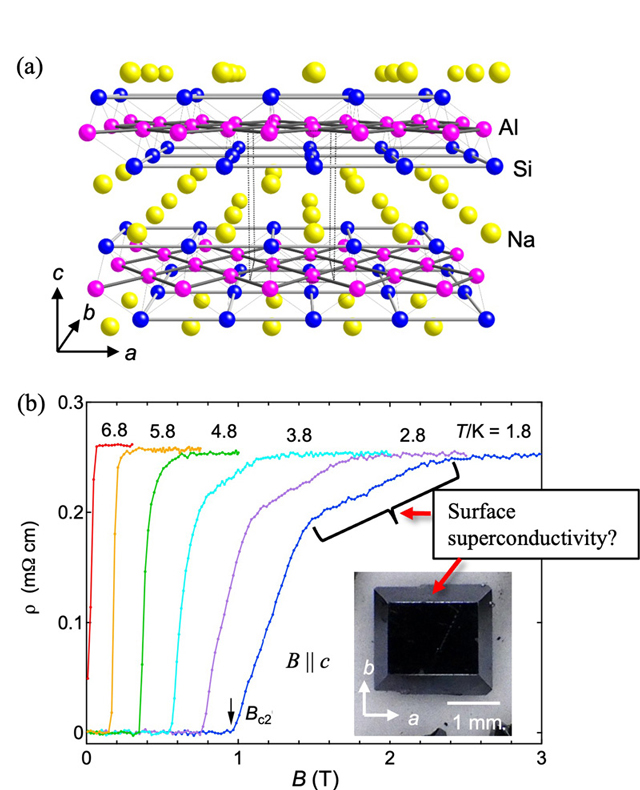PC3-2
Possible Surface Superconductivity in the Nodal-Line Semimetal NaAlSi
*Toshiya Ikenobe1, Daigorou Hirai1, Takahiro Yamada2, Hisanori Yamane2, Zenji Hiroi1
- Institute for Solid State Physics, University of Tokyo1
- Institute of Multidisciplinary Research for Advanced Materials, Tohoku University1
NaAlSi exhibits superconductivity below Tc = 6.8 K.1,2) It crystallizes in an anti-PbFCl type layered structure with the Al and Si atoms covalently bonded to form conducting layers separated by the layers of the ionic Na atoms (Fig. 1). The superconductivity seemed to be of the conventional s-wave type based on phonon-mediated Cooper pairing.3-6) However, very recent bulk measurements using single crystals of NaAlSi showed the possibility of a complex superconducting gap and electron correlation effects in the normal state properties,2) suggesting that something unusual is await to be uncovered.
Interestingly, electronic state calculations showed that NaAlSi is a nodal-line semimetal.5,7,8) Nontrivial topological surface states were predicted in the calculations; a drumhead band at around the point in the (0 0 1) surface and a flat band along the – line in the (1 0 0) surface.8) Superconductivity at such a topological surface state of the nodal-line semimetal has been discussed in a few compounds but still remained mystery.9,10)
We studied the resistive transitions under magnetic fields using plate-like single crystals of NaAlSi such as shown in Fig. 1. A significant reduction in resistivity was observed at a pre-transitional region above the bulk superconducting transition only in the case that the magnetic field was perpendicular to the plane, not parallel to the plane. Large sample (thickness) dependence, reentrant behavior, and sensitivity to the electrode setups in the resistive transitions at the pre-transitional region indicate that a part of crystal possesses an upper critical field larger than that of the bulk superconductivity. It is suggested that this fractional superconductivity occurs at the side surface of crystal or at around certain crystalline defects.
Fig. 1. (a) Layered crystal structure of NaAlSi. (b) Isothermal electrical resistivities of a NaAlSi crystal measured under magnetic fields applied along the c axis.2)
1) S. Kuroiwa, H. Kawashima, H. Kinoshita, H. Okabe and J. Akimitsu, Physica C 466, 11 (2007).
2) T. Yamada, D. Hirai, H. Yamane and Z. Hiroi, J. Phys. Soc. Jpn. 90, 034710 (2021).
3) L. Schoop, L. Müchler, J. Schmitt, V. Ksenofontov, S. Medvedev, J. Nuss, F. Casper, M. Jansen, R. J. Cava and C. Felser, Phys. Rev. B 86, 174522 (2012).
4) H. M. Tütüncü, E. Karaca and G. P. Srivastava, Philos. Mag. 96, 1006 (2016).
5) L. Muechler, Z. Guguchia, J.-C. Orain, J. Nuss, L. M. Schoop, R. Thomale and F. O. von Rohr, APL Materials 7, 121103 (2019).
6) H. Y. Wu, Y. H. Chen, P. F. Yin, Z. R. Zhang, X. Y. Han and X. Y. Li, Phil. Mag. Lett. 99, 29 (2019).
7) L. Jin, X. Zhang, T. He, W. Meng, X. Dai and G. Liu, J. Mater. Chem. C 7, 10694 (2019).
8) X. Yi, W. Q. Li, Z. H. Li, P. Zhou, Z. S. Ma and L. Z. Sun, J. Mater. Chem. C 7, 15375 (2019).
9) M. N. Ali, Q. D. Gibson, T. Klimczuk and R. J. Cava, Phys. Rev. B 89, 020505 (2014).
10) S.-Y. Guan, P.-J. Chen, M.-W. Chu, R. Sankar, F. Chou, H.-T. Jeng, C.-S. Chang and T.-M. Chuang, Sci Adv 2, e1600894 (2016).
